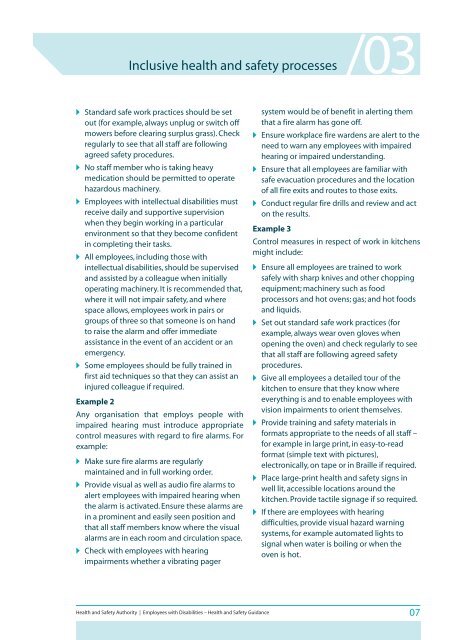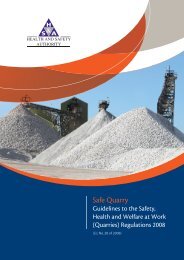Employees with Disabilities - Health and Safety Authority
Employees with Disabilities - Health and Safety Authority
Employees with Disabilities - Health and Safety Authority
You also want an ePaper? Increase the reach of your titles
YUMPU automatically turns print PDFs into web optimized ePapers that Google loves.
Inclusive health <strong>and</strong> safety processes /03<br />
<br />
<br />
<br />
<br />
<br />
St<strong>and</strong>ard safe work practices should be set<br />
out (for example, always unplug or switch off<br />
mowers before clearing surplus grass). Check<br />
regularly to see that all staff are following<br />
agreed safety procedures.<br />
No staff member who is taking heavy<br />
medication should be permitted to operate<br />
hazardous machinery.<br />
<strong>Employees</strong> <strong>with</strong> intellectual disabilities must<br />
receive daily <strong>and</strong> supportive supervision<br />
when they begin working in a particular<br />
environment so that they become confident<br />
in completing their tasks.<br />
All employees, including those <strong>with</strong><br />
intellectual disabilities, should be supervised<br />
<strong>and</strong> assisted by a colleague when initially<br />
operating machinery. It is recommended that,<br />
where it will not impair safety, <strong>and</strong> where<br />
space allows, employees work in pairs or<br />
groups of three so that someone is on h<strong>and</strong><br />
to raise the alarm <strong>and</strong> offer immediate<br />
assistance in the event of an accident or an<br />
emergency.<br />
Some employees should be fully trained in<br />
first aid techniques so that they can assist an<br />
injured colleague if required.<br />
Example 2<br />
Any organisation that employs people <strong>with</strong><br />
impaired hearing must introduce appropriate<br />
control measures <strong>with</strong> regard to fire alarms. For<br />
example:<br />
<br />
<br />
<br />
Make sure fire alarms are regularly<br />
maintained <strong>and</strong> in full working order.<br />
Provide visual as well as audio fire alarms to<br />
alert employees <strong>with</strong> impaired hearing when<br />
the alarm is activated. Ensure these alarms are<br />
in a prominent <strong>and</strong> easily seen position <strong>and</strong><br />
that all staff members know where the visual<br />
alarms are in each room <strong>and</strong> circulation space.<br />
Check <strong>with</strong> employees <strong>with</strong> hearing<br />
impairments whether a vibrating pager<br />
<br />
<br />
<br />
system would be of benefit in alerting them<br />
that a fire alarm has gone off.<br />
Ensure workplace fire wardens are alert to the<br />
need to warn any employees <strong>with</strong> impaired<br />
hearing or impaired underst<strong>and</strong>ing.<br />
Ensure that all employees are familiar <strong>with</strong><br />
safe evacuation procedures <strong>and</strong> the location<br />
of all fire exits <strong>and</strong> routes to those exits.<br />
Conduct regular fire drills <strong>and</strong> review <strong>and</strong> act<br />
on the results.<br />
Example 3<br />
Control measures in respect of work in kitchens<br />
might include:<br />
<br />
<br />
<br />
<br />
<br />
<br />
Ensure all employees are trained to work<br />
safely <strong>with</strong> sharp knives <strong>and</strong> other chopping<br />
equipment; machinery such as food<br />
processors <strong>and</strong> hot ovens; gas; <strong>and</strong> hot foods<br />
<strong>and</strong> liquids.<br />
Set out st<strong>and</strong>ard safe work practices (for<br />
example, always wear oven gloves when<br />
opening the oven) <strong>and</strong> check regularly to see<br />
that all staff are following agreed safety<br />
procedures.<br />
Give all employees a detailed tour of the<br />
kitchen to ensure that they know where<br />
everything is <strong>and</strong> to enable employees <strong>with</strong><br />
vision impairments to orient themselves.<br />
Provide training <strong>and</strong> safety materials in<br />
formats appropriate to the needs of all staff –<br />
for example in large print, in easy-to-read<br />
format (simple text <strong>with</strong> pictures),<br />
electronically, on tape or in Braille if required.<br />
Place large-print health <strong>and</strong> safety signs in<br />
well lit, accessible locations around the<br />
kitchen. Provide tactile signage if so required.<br />
If there are employees <strong>with</strong> hearing<br />
difficulties, provide visual hazard warning<br />
systems, for example automated lights to<br />
signal when water is boiling or when the<br />
oven is hot.<br />
<strong>Health</strong> <strong>and</strong> <strong>Safety</strong> <strong>Authority</strong> | <strong>Employees</strong> <strong>with</strong> <strong>Disabilities</strong> – <strong>Health</strong> <strong>and</strong> <strong>Safety</strong> Guidance 07

















